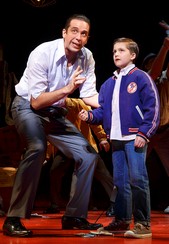
Nick Cordero and Hudson Loverrro (Joan Marcus)
I’m not surprised that “A
Bronx Tale: The New Musical” has found its way to Broadway following its run
last February at the Paper Mill House. It’s an okay show with a pleasing score,
a mostly predictable plot and ingratiating performances. It’s also okay if you, like
me, never saw “A Bronx Tale” either in its original
form as a one-man Off Broadway show in 1989, the 1993 fleshed-out film version,
or its return engagement on Broadway in
2007 in which its author and star Chazz Palminteri once again took the audience
back to the 1960s Bronx neighborhood of his youth and where he grew up under
the influence of two father figures, his own an upstanding bus driver and that of
the local Godfather.
The introduction, for myself, to this somewhat dark, purposefully
discomforting tale told in the light of its latest incarnation as a musical
turns out to be for the most part an enjoyable entertainment. This song-filled,
exuberantly acted and smartly staged trip down one man’s unapologetically
sentimentalized memory lane should please the folks who harbor nostalgic
memories of neighborhoods divided by racial lines and territorial gangsters.
Despite its tendency
(make that its aim), to romanticize the thugs and goons that reigned
over New York’s ethnic-divided neighborhoods as did also the more homogeneous
ones like Manhattan in the much more satirical “Guys and Dolls,” this
autobiographical musical does neither completely glorify nor wholeheartedly denounce
these denizens. Comfortable with killing as they are, these often deplorable characters
are, however cautiously idolized, in the eyes of its youthful narrator who as a
nine year-old witnesses a street killing.
Under the guidance of two directors Jerry Zaks (who directed
the stage version) and Robert De Niro (who directed the film), the production, has,
as its main asset, a vibrant score by Hollywood and Disney favorite Alan Menken
(“Little Shop of Horrors,” “Beauty
and the Beast,” “The Little Mermaid,” “Newsies,” “Aladdin”) that that essentially puts the show into its orbit. Its
joyously integrated pretensions of the Doo Op era are perfectly blended in the
best Broadway tradition.
Menken’s collaborator-lyricist Glen Slater (“Mermaid”) who
is also represented now on Broadway by “School of Rock,” has done beautifully
by empowering the ear-pleasing melodies with street lingo and with an unaffected
honesty. One song “Nicky Machiavelli,” in which top gangster Sonny (as played
with sustained panache by Nick Cordero) conveys to the young Calogaro (at the
performance I saw a wonderful Hudson Loverro who is alternating with Athen Sporek)
the philosophy that he acquired doing time in prison.
It’s that conflict of philosophies between the swaggering Sonny
and that of Calogaro’s loving but stern father Lorenzo (Richard H. Blake) that
is the basis for the plot. Lorenzo has to keep reminding Calogaro that there is
“nothing so sad as a talent that’s wasted.” Which philosophical perspective is
the one Calogaro is to believe confuses the impressionable youth. His choice,
as the musical would have us believe, basically determines his moral and
ethical path for the next eight years. The show effectively uses both the young
Calogero and an excellent Bobby Conte Thornton as the seventeen year-old
Calogero and who serves as is the musical’s narrator throughout as he also cleverly
shadows his younger self in the early scenes.
Not quite left in the shadows is Calogero’s loving mother
Rosina, played with warmth to spare by Lucia Giannetta who gets to reprise a
lovely ballad “Look to Your Heart” previously introduced by her husband and
son. The musical also considers the racial divide between the blacks who live
in the Webster Avenue section and the Italians who live in the Belmont Ave
section of the borough. A sweet but also dangerous romance blossoms between
Calogero and Jane a pretty black student who is appealingly played by Ariana
Debose. It triggers violence and a
tragedy. Notwithstanding shades of “West
Side Story” in the plot, the choreography by Sergio Trujillo is exciting as it
offers some dynamic dancing by both the black and white performers. There are
also sweet moments supplied by a street-corner doo wop quartet.
Beowulf Borritt’s spectacular set design frames the action
with towering rotating tenements with metal fire escape balconies, as well as
the row houses on 187 St and Belmont Avenue. The local bar and other locations
are seamlessly integrated, all under the superb lighting by Howell Binkley. As
expected, costume designer William Ivey Long captures the look of the era
perfectly with his expected flair. There is no doubt that the habitués of
Schubert Alley will enjoy this diverting trip to Belmont Avenue.
"A Bronx Tale: The New Musical"
Longacre Theatre, 220 West 48th Street
No comments:
Post a Comment